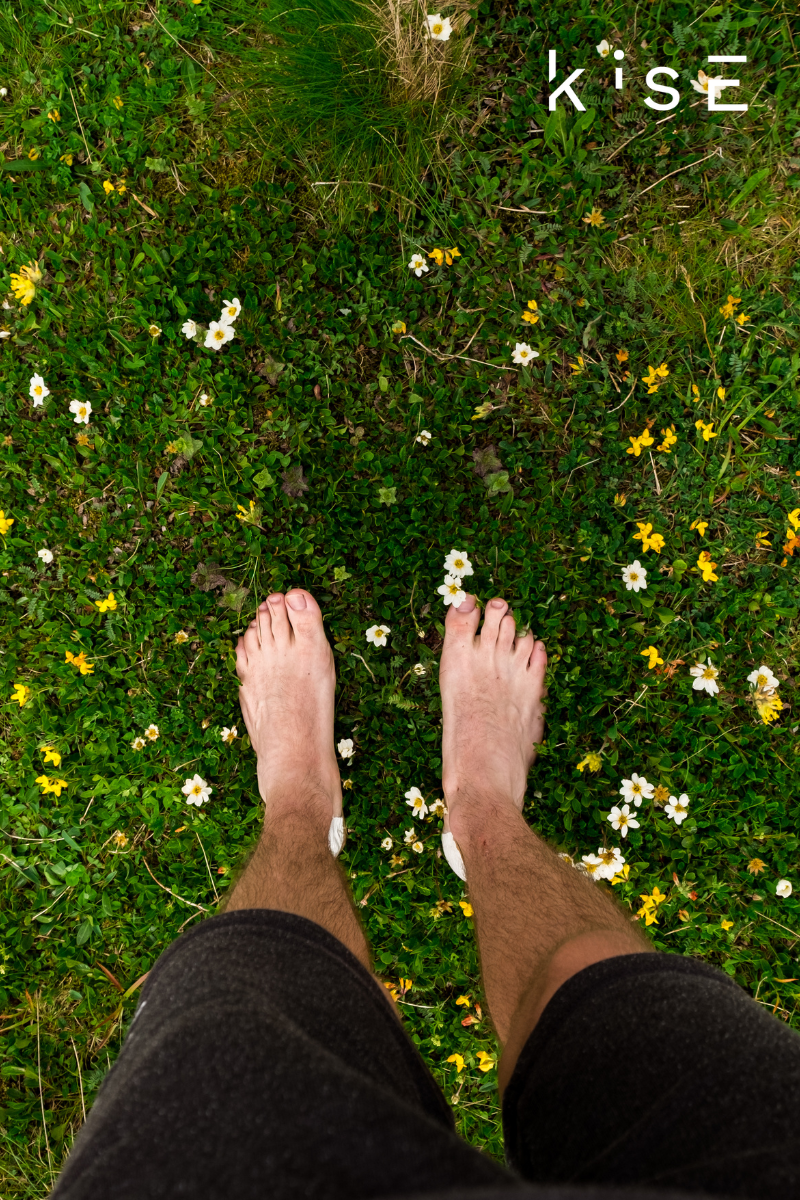This page may contain affiliate links – they are marked with a *. Making a purchase via my affiliate means I receive a small share of the sale.

Modern life often keeps us disconnected — not just from each other, but from the natural world. Yet there’s a growing body of research suggesting that something as basic as walking barefoot on the earth could offer real benefits for our mental wellbeing.
It’s called grounding (or earthing), and while it may sound a little “woo-woo” at first, the science backing it is surprisingly solid. From better sleep and less anxiety to reduced inflammation and more emotional balance, grounding is worth a second look — especially if you’ve been feeling a bit off lately.
What Is Grounding, Really?
At its core, grounding is about re-establishing our physical connection to the earth. When we walk barefoot on natural surfaces like grass, soil, or sand, we absorb electrons from the Earth’s surface — and those electrons can have a positive impact on the body.
Why does that matter? Because our bodies, like the Earth, carry electrical charges. And in our modern lifestyles — full of synthetic-soled shoes and hours spent indoors — we rarely get the kind of contact that allows those charges to rebalance. Grounding helps restore that connection, and research suggests it influences everything from stress levels to sleep quality.
The Science Behind the Barefoot Hype
It might sound simple, but grounding initiates real physiological changes. Several studies have shown that it can:
- Lower inflammation
- Improve sleep quality
- Reduce pain
- Shift the nervous system into a more relaxed state
- Balance cortisol (the stress hormone)
One small pilot study found that after just a few minutes of grounding, participants experienced decreased muscle tension, better blood flow, and changes in brainwave patterns — all signs that the body was moving out of “fight or flight” and into a calmer, more restorative mode.
Another study found that people who slept on grounding mats reported less pain, fewer sleep disturbances, and better overall wellbeing — with some even seeing improvements in asthma, PMS symptoms, and high blood pressure.
Why Grounding Could Be a Game-Changer for Mental Health
If you’ve been feeling anxious, low, or mentally drained, grounding offers a low-effort, natural way to feel more like yourself again.
Stress + Anxiety
Research shows that grounding helps regulate cortisol levels, supporting the body’s natural daily rhythm. Participants in one sleep study who were grounded for eight weeks reported fewer stress-related symptoms, including anxiety and irritability.
Even short grounding sessions — as little as 30 minutes — have shown immediate changes in brain activity and nervous system response. Simply put, it helps your body remember how to relax.
Sleep + Fatigue
Struggling to fall (or stay) asleep? Grounding has been linked with better sleep quality and improved morning energy levels. People report falling asleep faster, waking up less often, and feeling more refreshed — all without supplements or screens.
Some studies saw noticeable improvements after just a few weeks of regular grounding.
Mood + Emotional Balance
While it’s not a replacement for therapy or medication, grounding may help stabilise emotions. In studies, participants reported feeling more emotionally balanced and mentally steady after consistent grounding practices.
And the effects go beyond adults — one study found that premature babies in neonatal care showed improved nervous system regulation after being grounded.
How to Ground Yourself (Indoors or Out)
Getting started with grounding is easy. Here are the simplest ways to incorporate it into your day:
Go Barefoot Outside
Stand, walk, or sit barefoot on natural surfaces like grass, soil, sand, or stone. Gardening also counts — as does dipping your feet into a lake, river, or the sea.
Use a Grounding Mat Indoors
If the weather’s bad or you don’t have easy access to nature, grounding products like earthing mats, grounding sleep mats, and patches can help. These plug into a grounded outlet or use a rod outside to connect you to the Earth’s charge.
Make It a Habit
Even 10–30 minutes a day can be enough to see benefits. The key is consistency. A short barefoot break in the garden might be all it takes to start shifting your stress levels.
What to Look for in a Grounding Product
Not all grounding products are created equal. If you’re shopping for a mat, here’s how to spot a genuine one:
- It must connect to the Earth. Either through a grounded socket or a grounding rod placed in soil outside.
- Materials matter. Look for conductive materials like carbon. Cheaper mats made from non-conductive materials won’t work.
- Check the reviews. Go for established brands with clear explanations of how their products function.
- Test it. Some kits include testers so you can confirm conductivity.
Final Thoughts
Grounding isn’t a magic fix — but it is one of the simplest, most natural ways to support your mental and physical wellbeing. And it doesn’t cost a thing to try.
Whether you’re strolling barefoot through the garden, planting herbs with your hands in the soil, or using a grounding mat in your living room, reconnecting with the Earth might be just the calming, rebalancing practice your body and mind need.
No pressure. No rituals. Just you, the Earth, and a moment of pause.
Why not give it a go?
About Caroline Williams
Caroline Williams is a reflexologist and clinical massage therapist with a passion for holistic wellness. As the co-founder of BeGrounded, she combines her expertise in bodywork with a deep commitment to helping others reconnect with the natural world. Caroline’s approach emphasises the power of grounding practices to support both physical and mental health, making her a trusted voice in the wellness community.
